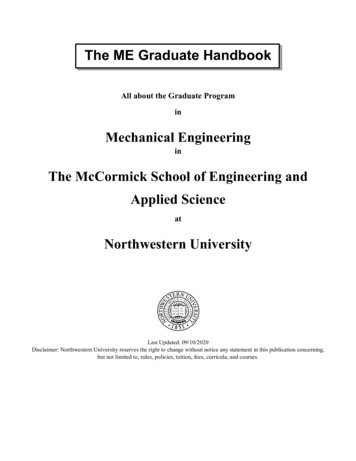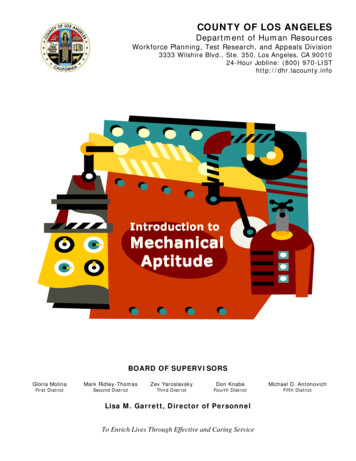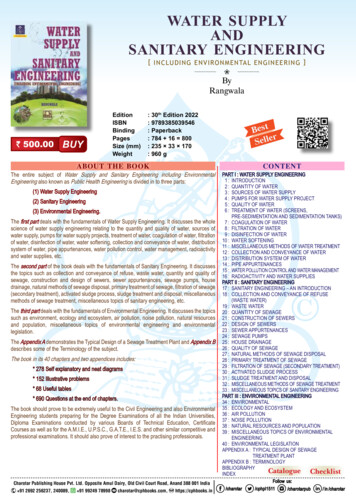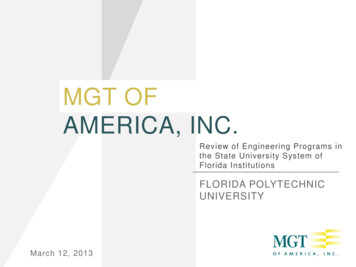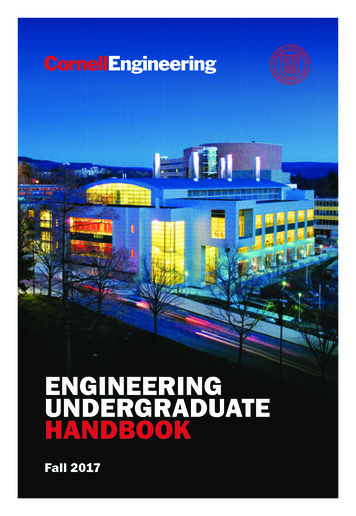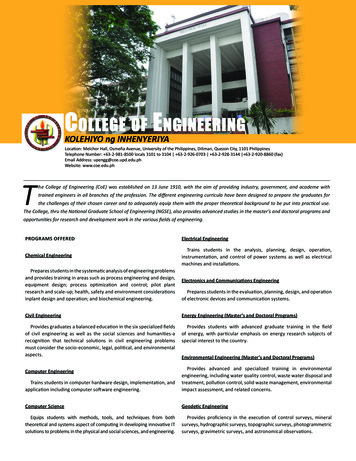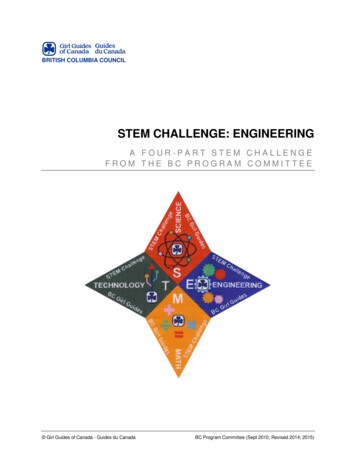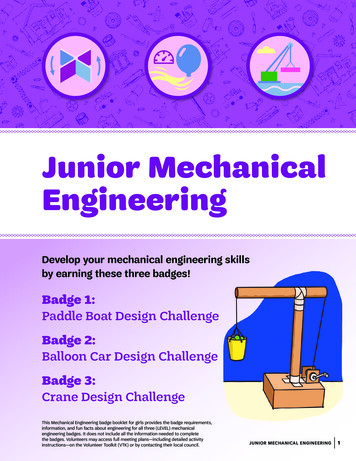
Transcription
Junior MechanicalEngineeringDevelop your mechanical engineering skillsby earning these three badges!Badge 1:Paddle Boat Design ChallengeBadge 2:Balloon Car Design ChallengeBadge 3:Crane Design ChallengeThis Mechanical Engineering badge booklet for girls provides the badge requirements,information, and fun facts about engineering for all three (LEVEL) mechanicalengineering badges. It does not include all the information needed to completethe badges. Volunteers may access full meeting plans—including detailed activityinstructions—on the Volunteer Toolkit (VTK) or by contacting their local council.JUNIOR MECHANICAL ENGINEERING1
Welcome to the world of mechanical engineering!When you’ve earned these three badges, you’ll know how to usethe Design Thinking Process to solve problems like an engineer.Every day, a mechanical engineer invents another machine tohelp people or solve a problem—such as nonpolluting carsor a better hearing aid.Who knows what machines we’ll need next! If solvingproblems excites you, you may want to think aboutbecoming a mechanical engineer so that you can inventthese machines yourself!2
Badge 1: Paddle BoatDesign ChallengePeople have been traveling by water for thousands of years. At first,boats, such as canoes, were powered by people. Later, boats were built touse other forms of energy to move, like catching wind in a sail.While earning this badge, you’ll explore how paddle boats work and usethe Design Thinking Process to engineer your own paddle boat.Steps1.2.3.4.5.Explore how paddle boats workDesign and build a rubber band-powered paddle boatTest your rubber band-powered paddle boatAnalyze and share your resultsBrainstorm ways to improve your designPurposeWhen I’ve earned this badge, I will know how to build and test a paddleboat and understand buoyancy, potential energy, and kinetic energy.JUNIOR MECHANICAL ENGINEERING3
1STEPExplore howpaddle boats workIf you’ve ever paddled a canoe or used the oars ona rowboat, you know that making a boat movetakes lots of energy. As boats got bigger, people had to findnew kinds of energy (besides just rowing). Some ships use sails.Others have engines powered by steam or electricity. There areeven some submarines powered by nuclear energy! All these boatsmove by using potential energy that is released into kinetic energy.Why DoBoats Float?Buoyancy is the force orpressure that pushes backagainst an object in thewater. Objects in the waterpush some of the water outof the way. The water pushesback against the object withthe same force as the waterit displaces. If an object isheavier than the water itdisplaces, it will sink.In the 1800s and early 1900s, steam-powered paddle boats became very common.2STEPDesign and build arubber band-poweredpaddle boatEngineers solve problems. When an engineer is workingon a project, she asks lots of questions and then experiments tofind the answers.When tackling a problem, she follows certain steps which arecalled the Design Thinking Process. Use the Design ThinkingProcess to design and build your rubber band-poweredpaddle boat.4
WORDSTO KNOW An axle is a bar or spindle on which things can rotate, such as a rod passingthrough the center of each paddle. Ballast is weight that is used to keep a boat upright. Buoyancy is the force or pressure that pushes back on an object in thewater. When an object is placed in water, it causes the water to push againstit with the same force as the weight of the water it displaces. This is calledArchimedes’ Principle. The Design Thinking Process is the way engineers solve problemsand build solutions. They define the problem, brainstorm and plan, build, test,and improve. Engineers are people who solve problems. They use their imaginations toinvent new things like self-driving cars. They also come up with new and betterways to build things such as bridges, buildings, and planes. Force is the strength or energy that creates movement. Push and pull areexamples of forces. Kinetic energy is when potential energy is released. Kinetic energymakes bodies and objects move. Potential energy is the energy stored in your body and everything else inour world. A prototype is a quick way to show your idea to others or to try it out. Itcan be as simple as a drawing or it can be made with everyday materials likecardboard, paper, string, and rubber bands.JUNIOR MECHANICAL ENGINEERING5
3STEPTest your rubberband-poweredpaddle boatSo you built a paddle boat, but how do you know if itworks? Engineers always test their inventions to learn about whatworks and what doesn’t. They don’t expect their products to workPeople PowerPeople use their arms andlegs to power boats everyday. Rowboats move bypeople pushing and pullingon oars. Some people evenrace in special row boatscalled sculls or racing shells.Canoes, kayaks, stand-uppaddleboards, and gondolasare other examples of boatsmoved by paddles or oars.Rafts or punts are moved bypeople pushing a pole intothe bottom of the river. Andsome boats are poweredby people pedaling, movingpaddles like the ones in apaddle boat.perfectly the first (or even second or third) time they test them.In fact, engineers use what they learn from failures in their teststo change and improve their inventions. Failing is an importantpart of the design process. Now you have a chance to see yourpaddle boat in action!4STEPAnalyze and shareyour resultsWhen engineers test their inventions, theyusually are surprised by what happens. Theytake time after the test to think about what happened andwhat they can learn from it. Thinking about test results carefullyis called “analyzing.”Sharing your results with others is an important step, too, becauseother people may have great ideas about your project. Thinkcarefully about what happened when you tested your paddle boatand talk with others about what happened and what you, andthey, think it means.results6
Design ThinkingProcessThe Design Thinking Process is the way engineers solve problemsand build solutions.BRAINSTORM SOLUTIONSDEFINE THE NEEDBUILDDESIGNREDESIGNTEST &EVALUATEITERATE &IMPROVESHARE YOUR WORKGOODTO GO!JUNIOR MECHANICAL ENGINEERING7
5STEPBrainstorm ways toimprove your designEngineering is about making things better. Whenyou invent something, making changes to your original idea ispart of the process.Sometimes your test results will clearly show what kind ofchanges you should make, but sometimes you have to use yourimagination. Brainstorming with fellow engineers is a great wayto come up with design improvement ideas and add more waysof thinking about your problem.Now that you’ve analyzed your testing results, how could youimprovementsimprove your paddle boat?88Brainstorm
Now that I’ve earned this badge, I can give service by: Encouraging my friends and Girl Scout sisters to explorescience and engineering.Using the Design Thinking Process to solve problems for others.Teaching others about potential energy, kinetic energy, and buoyancy.I’m inspired to:JUNIOR MECHANICAL ENGINEERING9
Badge 2: Balloon CarDesign ChallengeCan you imagine riding in a horse-drawn carriage to get to school? It wasn’tso long ago that most people used animals as their main form of transportation,but over time we’ve come up with different ways to fuel our rides. Today, thegasoline-powered car is how most people get around, but engineers continueto explore how other kinds of energy can move vehicles. In this badge, you’lllearn about air power and create an alternative fuel car.Steps1.2.3.4.5.Learn about potential and kinetic energyDesign and build a balloon carTest your balloon-powered carAnalyze and share your resultsBrainstorm ways to improve your designPurposeWhen I’ve earned this badge, I will know how to engineer a balloon-poweredcar and understand potential energy, kinetic energy, and jet propulsion.10
1STEPLearn about potentialand kinetic energyEngineers have to understand all aspects of theirproject. That means knowing about the materials they can use,what those materials can do, and how scientific concepts canaffect their project.If an engineer wants to make an invention that moves, she has toknow about potential and kinetic energy. There are lots of ways tostore potential energy—in batteries, in springs, and even in yourmuscles. No matter how it is stored, when potential energy getsconverted to kinetic energy, things MOVE! For example, when youbend your knees, they store potential energy that turns intokinetic energy that lets you launch up and jump!How can you use air as your car’s source of energy?POTENTIAL ENERGYJet PropulsionAirplanes use jet engines tofly us quickly from one placeto another. Airboats use hugefans to push flat-bottomedboats around shallowwater like the Everglades.Astronauts use jet packs tomove around outside theirspacecraft. And squids,octopuses, and even somejellyfish use jet propulsionto shoot themselves throughthe water.The reason they all moveis that the air or watershooting away fromthe object pushes it inthe opposite direction.In the late 1600s, SirIsaac Newton, an Englishscientist, philosopher, andmathematician, figuredout that for every action,there is an equal andopposite reaction (Newton’sThird Law), which explainsjet propulsion.KINETIC ENERGYJUNIOR MECHANICAL ENGINEERING11
WomeninventorsWhat do windshield wipers, disposable diapers, and paper bagshave in common? They were all invented by women.The paper bag with a flat bottom was invented byMargaret Knight in 1868. Before she changed thedesign, paper bags were shaped like envelopes andcouldn’t stand up on their own.Mary Anderson invented the first windshieldwipers for cars in 1903. Her version had a lever to pullthat would clear rain or snow from the windshield. Atfirst, people didn’t think it was a good idea, but by the1920s, cars had automatic windshield wipers.No more soggy diapers! Marion Donovan inventeda waterproof cover for cloth diapers out of a showercurtain in 1951 and sold it at Saks Fifth Avenue, a fancyclothing store. A few years later, she invented the firstcompletely disposable paper diaper.12
2STEPDesign and builda balloon carEngineers use ideas like potential and kineticenergy to build things. They also use the Design ThinkingProcess to guide them as they imagine, design, build, test, andimprove their ideas.Use what you know about energy, thrust, and jet propulsion todesign and build your balloon car.3STEPTest yourballoon-powered carJet CarsCars powered by jet enginesare the fastest around. Theyuse fuel-powered enginesto create jet propulsion.Sometimes they are used indrag races, and they’ve alsobeen used to set land speedrecords. The fastest jet carwent more than 760 milesper hour over one mile!In school, you take a test after a number ofclasses to measure how much you know. Engineersuse tests while they are developing new products to help themlearn about what is working and what isn’t.In many ways, testing an invention isn’t the end of the process,but a new beginning. Testing your balloon-powered car will letyou see not only how fast it goes, but also if it does anythingunexpected, like swerving off to the side.JUNIOR MECHANICAL ENGINEERING13
4STEPAnalyze andshare your resultsEngineers think about what their results meanafter they test their inventions. For example, theymight ask themselves questions like, “My car didn’t drive straight—why?” or “My invention didn’t work—what happened?” When anengineer thinks carefully about what happened during a producttest, she analyzes her results. She can learn as much—and maybeeven more—from analyzing a failure instead of a success.By sharing, she invites others to offer their ideas about herproject. She could also inspire someone else working on adifferent, or even similar, problem. Ask “why?” to find out whathappened to your car during testing.5feedbackSTEPBrainstorm waysto improve your designEngineering is a process—a series of steps toachieve a goal. An engineer’s goal is to build the best possiblesolution to a problem. That means looking for ways to improve onher first (or second or third) design of a product.Working with other people to imagine improvements is a good idea.If you only work alone, you might miss some good ideas for change.Brainstorm with others how to improve your balloon car design.14
Alternative Powerfor CarsMost of the cars on the road today burn gasoline or diesel to make their engines run.That’s a problem because those cars create pollution and our fuel supply is limited. Now,engineers are exploring all kinds of ways to power vehicles to find a solution that is goodfor people and the environment.Electric cars—You can buy cars that use gasoline and electricity or only electricityto make them run. When a car uses both gas and electricity, it’s called a hybrid. Inhybrids, the electric energy is created when the driver hits the brakes. The energy fromthe moving wheels gets transferred to a battery as potential energy.Then, when the driver pushes the accelerator, that energy gets transferred back to theaxle and wheels as kinetic energy. Gasoline is burned to power the engine when thereisn’t enough energy in the battery.Solar-powered cars—Engineers are working on creating cars powered by solarenergy. Some designs, like the German Sono, use solar cells on the outside of the car tocollect solar energy and turn it into electricity.Used vegetable oil-powered cars—Usually used oil just gets thrown awayafter cooking, but it’s possible to make a diesel engine that uses waste vegetable oil.The main challenge is that drivers have to go to restaurants or factories (like potatochip factories) to get the oil and filter it before they can use it in their cars. There are noveggie oil filling stations yet!Human waste-powered cars—The city of Bristol, England, developed a busthat runs on biomethane—a gas created from human waste. To generate power, thelocal sewage treatment plant converts what goes downthe toilet and food waste into methane gas. Thebus fills up its tank at the sewage treatmentplant and drives all over town. Thesebuses produce less pollution thantraditional buses, and they arequieter, too!JUNIOR MECHANICAL ENGINEERING15
Now that I’ve earned this badge, I can give service by: Encouraging my friends and Girl Scout sisters to explorescience and engineering.Using the Design Thinking Process to solve problems for others.Teaching others about the scientific concepts I learned, such asjet propulsion, thrust, and potential and kinetic energy.I’m inspired to:16
Badge 3: CraneDesign ChallengeFor thousands of years, people have used cranes to build very tallbuildings and move heavy objects. As the size and shape of the buildings wemake change, so has the crane’s design. A crane might look complicated, butit’s just a combination of simple machines. Learn about simple machines,and how they work together, and then build your own heavy-lifting crane.Steps1.2.3.4.5.Explore simple and compound machinesDesign and build a craneTest your craneAnalyze and share your resultsBrainstorm ways to improve your designPurposeWhen I’ve earned this badge, I will know how to build and test a crane andunderstand simple and compound machines.JUNIOR MECHANICAL ENGINEERING17
1STEPExplore simple andcompound machinesArchimedes was an ancient Greek philosopher,but he was also a scientist and an engineer. HeHeavy LiftingThe ancient Greeks andRomans used cranes to liftheavy objects and constructsome of their most famousbuildings. They used peopleor animals to pull the ropesthat would run throughpulleys and along the arm ofthe crane to lift.The French improved oncrane design in the MiddleAges to move freight outof ships and to buildGothic cathedrals.Today, cranes use internalcombustion engines (likethe ones in cars), electricmotors, or hydraulics forpower. Cranes are still usedin shipyards and constructionsites, and there are evenfloating cranes to helpwith bridge and offshoreconstruction projects.18discovered the principles of mechanical advantage, or how usinga tool like a lever can multiply a person’s strength or ability. Heexplored different types of simple machines and how they can beused together to make compound machines.Be like Archimedes and learn about what simple and compoundmachines can do for you!2STEPDesign and builda craneIf you aren’t super strong, you’ll need help liftingsomething really heavy. That’s ok, though, because as anengineer, you can design and build a crane to help you.Engineers use the Design Thinking Process to imagine solutionsto their problems, and then design and build a product that mightwork. They apply scientific ideas and use the materials availableto make their invention.Now it’s your turn to engineer a heavy-lifting crane. Use what youknow about simple machines and the materials you have onhand to build your crane.ideas
SimpleMachinesPeople use versions of simple machines every day,either on their own or together as compound machines.WEDGEPULLEYLEVERSCREWWHEEL AND AXLEJUNIOR MECHANICAL ENGINEERING19
3STEPTest yourcraneBefore an engineer sends her newly designedcrane to work on a big job, she wants to be sureher crane will perform the way she needs it to.Engineers test their inventions as part of the Design ThinkingProcess, so that they can fix or improve things that don’t workas well as they could.Testing provides valuableinformation, or data, thatengineers use to make abetter final product.Test your crane to seehow much weight it canlift. Record yourobservations and resultseach time you test.4STEPAnalyze and shareyour restultsData is information that engineers receive,collect, or observe about their design. Collecting dataabout how an invention performs is one task an engineer does allResultsthe time. Using that data is another.Engineers think carefully, or analyze, their test results to betterunderstand how their inventions work or don’t work. They sharetheir results and analysis with others to get feedback on their project,looking for the best possible understanding of what happened.When you analyze and share the results of your crane test withyour fellow engineers, you are taking an important step inmaking a better crane.20
WomEnengineersIn the late 1800s, Emily Warren Roeblingtook over the job of chief engineer during theconstruction of the Brooklyn Bridge when herhusband, who had the job, was too sick to work.She ended up overseeing the completion of thebiggest engineering project of its time.Actress Hedy Lamarr created the basis for today’s Wi-Fi,GPS, and Bluetooth when she was trying to make a secretway for soldiers to talk to each other during World War II.She also improved airplane design by studying birds andfish, combining different features from both animals to makeplanes that can fly faster.Special superstrong fabric isn’t just for superherocapes. Stephanie Kwolek, a research chemist,invented Kevlar, a fire-resistant, lightweight, strongmaterial that is used in bulletproof vests, crashhelmets, and other protective clothing.JUNIOR MECHANICAL ENGINEERING21
5STEPJob OpeningIf you want to work in acrane, you’d better likeclimbing! You also need tobe really good at movingsmall objects, concentrating,and communicatingwith others.Engineers love solving problems and workingtogether to make the best inventions possible.The operators for towercranes, like the ones you seeat construction sites, haveto climb up ladders (200 to500 feet every day) to getto their “offices.” Once theyare in their “cab,” they sit ina special moving chair andwork a joystick and a lever tomove the crane arm and tolift and lower things.all down. Brainstorm ways to improve your heavy-lifting crane byCrane operators have tobe very precise becausean inch of movementin the lever or joysticktranslates into a muchlarger movement by thecrane and its cargo. Whenyou’re moving heavy objectsthrough the air, you haveto talk with folks on theground to make sure you’redoing that safely. Whileconstruction jobs usedto be only done by men,more and more womenare getting into theindustry, including doingjobs as crane operators.22Brainstorm ways toimprove your designBrainstorming, or working with others to imagine all kinds ofimprovements, is one way engineers help each other make theirdesigns better.When you are brainstorming, no idea is too crazy, so write themanalyzing your test results and using what you’ve learned.improvements
Now that I’ve earned this badge, I can give service by: Encouraging my friends and Girl Scout sisters to explore scienceand engineering. Using the Design Thinking Process to solve problems in my community. Teach others about simple or compound machines or the DesignThinking Process.I’m inspired to:JUNIOR MECHANICAL ENGINEERING23
2018 Girl Scouts of the United States of America.All rights reserved. No part of this publication may be reproduced, distributed, or transmitted in any form or by any means,including photocopying, recording, or by any other electronic or mechanical methods now known or hereinafter invented,without the prior written permission of Girl Scouts of the United States of America, except in the case of brief quotationsembodied in critical reviews and certain other noncommercial uses permitted by copyright law. For permissions requests,write to Girl Scouts of the United States of America at the address below or visit the www.girlscouts.org website to accesspermission request forms.Links to third-party websites are provided for convenience only. Girl Scouts of the USA (GSUSA) does not endorse nor supportthe content of third-party links and is not responsible for the content or accuracy, availability, or privacy/security practices ofother websites, and/or services or goods that may be linked to or advertised on such third-party websites. By clicking on athird-party link, you will leave the current GSUSA site whereby policies of such third-party link may differ from those of GSUSA.First published in 2018 by Girl Scouts of the USA420 Fifth Avenue, New York, NY 10018-2798www.girlscouts.orgPrinted in the United StatesStock images by: Adobe StockSpecial thanks to our partner WGBH Educational Foundation.PADDLE BOAT DESIGN CHALLENGE—Adapted from the Design Squad Global “Paddle Power” activity. 2017 WGBHEducational Foundation. Design Squad is a registered trademark of the WGBH Educational Foundation.BALLOON CAR DESIGN CHALLENGE—Adapted from the Design Squad Global “Build a 4-Wheel Balloon Car” activity. 2017 WGBH Educational Foundation. Design Squad is a registered trademark of the WGBH Educational Foundation.CRANE DESIGN CHALLENGE—Adapted from the Design Squad Global “Heavy Lifting” activity. 2017 WGBHEducational Foundation. Design Squad is a registered trademark of the WGBH Educational Foundation.24
While earning this badge, you’ll explore how paddle boats work and use the Design Thinking Process to engineer your own paddle boat. Steps 1. Explore how paddle boats work 2. Design and build a rubber band-powered paddle boat 3. Test your rubber band-powered paddle boat 4. Analyze and share your result

